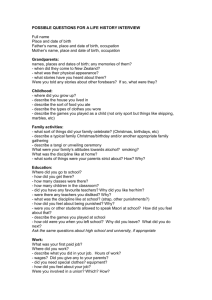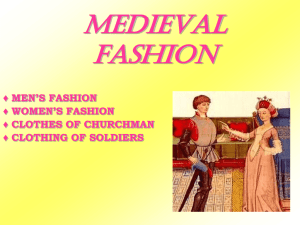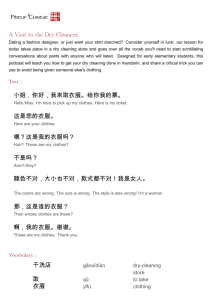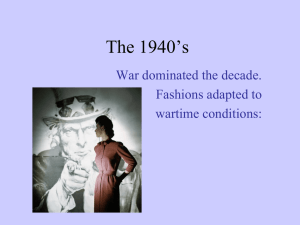A tailor
advertisement
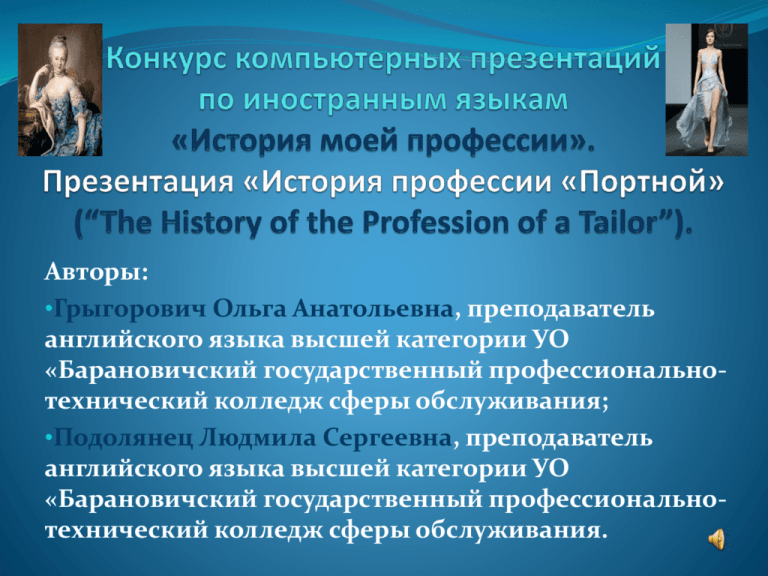
Авторы: •Грыгорович Ольга Анатольевна, преподаватель английского языка высшей категории УО «Барановичский государственный профессиональнотехнический колледж сферы обслуживания; •Подолянец Людмила Сергеевна, преподаватель английского языка высшей категории УО «Барановичский государственный профессиональнотехнический колледж сферы обслуживания. The Contents of the Presentation. The Title. Slide 1. The Contents. Slide 2 The Profession of a Tailor. Slide 3. The Birth of Tailoring. Ancient Times. Slide 4. Ancient Greece. Slide 5. The Middle Age. Europe. Slide 6. The Renaissance. Slides 7-8. The 17th-18th centuries. Slides 9-10. The 19th-2oth centuries. Slides 11-12. The 21st century. Slide 13. Active Vocabulary. Slide 14. Some Interesting Facts about Tailoring and Fashion. Slides 15-16. Tailoring and Fashion. Speech Practice. Slides 17-19. The List of the Resources. Slide 20. The Profession of a Tailor. A tailor is a person who makes, repairs, or alters clothing professionally. A tailor must be attentive, accurate, patient. Usually the work of tailors is connected with people and they must be able to communicate with their clients. Good clothes open all doors The Birth of Tailoring. Ancient Times. At first clothes were just a shelter from weather phenomena such as strong wind or heavy rain. Ancient people sew parts of fur and leather to protect themselves from cold and nasty weather. They use stone needles to do it that became the first step to creating tiny clothes. The next important step of tailoring was the invention of fabrics. Ancient Greece. In ancient Greece tailors began to work in special workshops and it was usual to use the work of slaves for tailoring. A tailor-master was the chief of such a group and sew clothes himself. The others did the preparations for the work: producing the material, cutting and pressing it. Despite the warm climate Greek women wore clothes that covered most of their bodies. Greek men wore plain tunics of wool tied at the waist. The Middle Age. Europe. In Europe the knowledge and art of tailoring, cutting and sewing cloth developed slowly and gradually between the twelfth and fourteenth centuries. The Oxford English Dictionary's first reference to the word "tailor" gives the specific date of 1297; and certainty by that date tailoring guilds, as well as those of weavers, and cloth merchants were well established in Europe. During the Middle Ages clothing was regarded as a means of concealing the body and in the 12th and 13th centuries clothes were still quite basic. Men wore tunics and tights or stockings. Women wore a nightie-like linen garment. They wore a long tunic (to their ankles) and over it another garment, a gown. Women held their dresses with a belt tied around their waists. Both sexes wore clothes made of wool but it varied in quality. The Renaissance (the 14th-16th centuries). With the Renaissance the accentuation of the human form came. The loose robe was shortened and tightened, and eventually cut, pieced, and sewn together in attempts to bring into prominence the contours of the human form. This was the birth of fashion. Master tailors in the growing towns eventually became responsible for the clothing needs of the society, and the art and science of tailoring became a highly specialized, complex, and jealously guarded craft. For the wealthy styles changed rapidly. Clothes became much more elaborate. Women wore elaborate hats and men wore long shoes. Poor people wore practical clothes. If it was wet and muddy they wore wooden clogs. The Renaissance. The tailoring was respected and it took a lot of time to get the qualification of a tailor. Parents give their children to a master tailor for some fee. They are taught to cope with a needle and a thread. Then they learnt the art of cutting out. After five-seven years they got the qualification of an apprentice. Apprentices couldn’t marry but got some money and could become a pupil of another master. Apprentices got the qualification of a master when they created a real costume themselves. The th th 17 -18 centuries. In the 17th-18th centuries the art of tailoring continued to develop. In the 17th century in France a new profession appeared. It was the profession of a milliner and it was the final division of tailoring into male and female masters. A tailor created clothes for men, a milliner created dresses and hats for women and a seamstress created underwear. The th th 17 -18 centuries. The arbiter of fashion for Europe of that time was France. In the 17th and 18th centuries men wore knee length, trouser like garments called breeches and stockings. Also they wore linen shirts. Women in the 17th century wore a linen nightie like garment called a shift. Over it they wore long dresses. The dress was in two parts: the bodice and the skirt. In the 18th century they wore stays (a bodice with strips of whalebone) and hooped petticoats under their dresses. The th th 19 -20 centuries. The 19th -20th centuries were the turning point of producing ready-made clothes. Good conditions for it were created by the Great French Revolution. At first ready-made clothes were mainly for men and clothes for women were still created by an individual order. The first workshops of ready-made clothes sewed outer-clothes and different accessories for women. In 1820 the first paper patterns appeared that were produced by the firm “Smith” in London. Also in the 19th century the first sewingmachines appeared and the profession of a tailor became even more popular. The 19th-20th centuries. In the 19th century and at the beginning of the 20th century men wore trousers, cotton shirts, waistcoats and coats. But after the First World War men’s clothes became less informal and more casual. They often wore pullovers instead of waistcoats. In the early 19th century women wore light long dresses. In the 1850s they wore frames of whalebone or steel wire called crinolines under their skirts. About 1800 women started wearing underwear. But a revolution in women’s clothes occurred in 1925 when they began wearing knee length skirts. In the second half of the 20th century clothes for both sexes became very varied and fashion changed very rapidly. The st 21 century. The 21st century is the century of ready-made clothes. There are a lot of large factories where any clothes you need are made. On the other hand tailor-made clothes are also popular and in any city there are a lot of tailors who will sew something for your personal taste. The profession of a tailor is very popular and some tailors are very famous and successful today. In the 21st century fashion is extremely various and every person can wear anything that he/she likes. Active Vocabulary. Tailoring -портняжное дело Tailor -портной Milliner -модистка Seamstress -белошвейка Apprentice -подмастерье Sew -шить Cut out-кроить Needle -игла Thread -нитка Iron -утюг Scissors -ножницы Pattern -выкройка Fabric -ткань Workshop -мастерская Wear (wore) -носить Garment -предмет одежды Some Interesting Facts about Tailoring and Fashion. “The supremacy of a needle and scissors” is considered to begin in the 13th century. An iron has been known since the 9th century in France. The first project of a sewing-machine was offered by Leonardo da Vinci in the 15th century but it wasn’t created. In 1913 Mary Crosby invented the modern bra. She used two handkerchiefs joined by ribbon. The bikini was invented in 1946. In 1965 the mini skirt was invented by Mary Quant. Some Interesting Facts about Tailoring and Fashion. The arbiter of fashion in Europe of the 18th century was France. The main source of information about fashion was the 1st magazine about fashion which was called “The Gallant Mercury”. Marie-Antoinette, the queen of France, wanted to become “the queen of fashion”. She desired to be the most fashionable woman in Europe and changed her dresses three times a day. Clothes for her were created by her milliner, Rose Bertin. She was called “the minister of fashion”. Tailoring and Fashion. Speech Practice. 1. 2. 3. 1. 2. 3. Remember the information of the presentation. Speak about the role of the profession of a tailor in different times. Speak about changes of fashion in different times. Speak about some inventions that made tailoring easier and (or) more popular. The aim of a profession of a tailor is to make clothes. Read the statements about clothes and explain their meanings. Do you agree with them? Give some facts to prove them. Clothes do not make a man. All that glitters is not gold. Good clothes open all doors. Tailoring and Fashion. Speech Practice. Look at the pictures of people belonging to different ages and different times and describe their clothes. Have clothes changed much since the previous times? To what extent do you think it reflects the values of different times? What styles (clothes) do you like/ prefer? Describe your favourite clothes. Tailoring and Fashion. Speech Practice. Look at the pictures. Role play a possible dialogue between the tailor and the client. You may use the following phrases: -I’d like to order a new... -I want something for… -I’d like to choose some fabric from… -Will you help me to choose… -Please, take my measurements. -Does the colour suit me? -Can you make it a little bit shorter/ narrower? The List of the Resources. 1. Аксенова М, Дукельская Е., Евсеева Т. Мода и стиль. Аванта, 2002. 2. Васильев Александр. Официальный сайт: http://vassiliev.com.ru. 3. Волченко Л.Б. Этикет и мода. - М., 1989. 4. Гофман А.Б. Мода и люди. - М., 1994. 5. Демшина А. Ю. Мода в контексте визуальной культуры: вторая половина ХХ – начало XXI вв.// электронная библиотека FictionBook.ru: http://fictionbook.ru. 6. Кибалова Л., Гербенова О., Ламарова М. Иллюстрированная энциклопедия моды. - Прага: Артия, 1987. 7. Хведченя Л.В. «Практический курс современного английского языка», 2002 8. Энциклопедия моды: http://www.compromesso.ru/.
